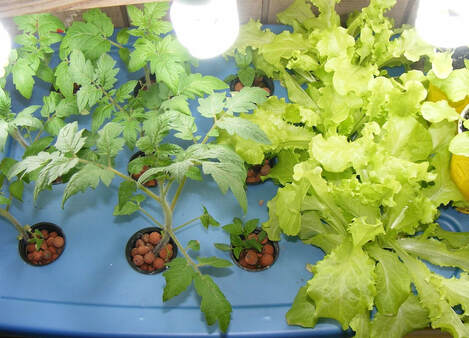|
Living here in northern Wisconsin, and being a gardener, I wanted to break the barriers to gardening that our harsh winters create. This year, I am experimenting with hydroponics. Hydroponics, in its simplest form, is growing plants by supplying all necessary nutrients in the plants’ water supply rather than through the soil. Plants need water, nutrients, light, air, and structural support for the roots. There are two types of hydroponic systems: active and passive. I have had a passive system when our Master Gardener Kids in the Garden program repurposed plastic bottles that had a “wicking” material to draw up the liquid nutrients for the roots to access by simply suspending the plants in the inverted bottle top and placing the container in a sunny window. That works well in Summer, but not at all in Winter. There is simply not enough natural light for the plant to grow, given our shorter winter daylight hours. I do not have a lot of room in my home for racks of plants grown the traditional way in soil. So, I turned to an active hydroponic system. I purchased a system with an air pump that supplies 1 liter of Oxygen/min per 5 gallons to move the nutrients in and out of the root zone area and to provide aeration. All plants require light for photosynthesis, the process within a plant that converts light, oxygen, and water into carbohydrates (energy). An LED plant growing light with a timer keeps the light on for 15 hours daily. LED’s create little heat, are energy efficient, and the Red & Blue bulbs cast a purple light that is great for growing plants.
My choice is a water-culture system that does not use any medium other than water, which requires a support material such as wire mesh to keep the plants from drowning. I chose white fabric pots that are reflective in cold environments and can be reused. This provides regular contact between the plant roots and the nutrient solution. A PH meter with a built-in thermometer checks for the target temperature of 65 – 70 degrees Fahrenheit, which makes nutrients most available to plants and a PH target of 5.8 to 6.5. (PH is a measure of the acidity and alkalinity on a scale of 1 to 14, with 1 being very acidic, 7 being neutral, and 14 being very alkaline). A fan is used to provide airflow. Leafy crops like lettuce and herbs tend to do better in water culture than do fruiting crops like tomatoes, cucumbers, or peppers. I started with herbs – basil (Genovese and Thai), parsley, dill, mint, and thyme. I purchased a prepared hydroponic nutrient in liquid form. You can do it yourself, but I wanted a “sure thing” for my first hydroponic experience. Tap water is used that stands uncovered for a couple of days to eliminate any significant concentrations of chlorine, which can adversely affect plant growth. As on option, you could purchase distilled water and use it immediately. Nutrient solution is added every two weeks. Water levels are checked frequently and topped off with more water to avoid building up concentrations of mineral salts. This water will be recycled after harvesting the herbs by watering my other indoor plants, refresh my container, and get ready to plant lettuces. After three weeks from plant date, I have been pinching off the dill to put in with my hummus, and the basil is being used for caprese salads. I am using the mint in my afternoon tea. The other two herbs, parsley, and thyme are almost ready to harvest. I have always been a more traditional gardener, using only soil and soilless mixes, yet I have become a convert to hydroponics. This summer, I will use a “DIY” solution to prepare some PVC pipes to grow tomatoes and peppers outdoors hydroponically. I hope you will give hydroponics a try! It will extend your growing season and give you fresh herbs and lettuces during the winter that will remind you Summer is not far away. Submitted by Roseann Meixelsperger Master Gardener January 29, 2021 Photo Credit: unknown author, licensed by CC BY-SA
0 Comments
Leave a Reply. |
|
| North Country MGV | gARDEN bLOGS |
Location |
|

 RSS Feed
RSS Feed